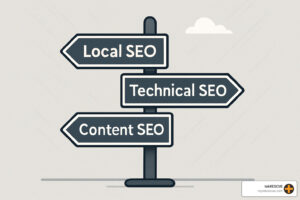

How to Create an Effective Landing Page – Part 1 From your web design team in Austin TX
“First impressions are everything”, says the age old adage. When a customer visits your website’s homepage, they will immediately make a judgement call on if the website matches what they are looking for. This means that you have about 30 seconds to get and keep their attention. It’s like the internet’s version of window shopping. When you are in a mall, you are going to look into the window of a store to get the intent of what they offer and what they do.
A website should exist to inform and then connect visitors with you. This comes from our mission statement as a company to make technology that works for you and enhances your life. And our website design stems from this philosophy. It should be easy to use, simple, and elegant. In this series we will be looking at how to effectively use a landing page for increasing visitor interaction and retention and turning those visitors into actual customers.
What Should a Landing Page Include?
The first thing we will look at is what is important enough to include on a landing page, as the more cluttered the more likely the visitor will back out before they read the info that would have kept them on the site. Keep in mind that this isn’t a 100% rule, and that there will be exceptions. For example, there may be differences between what a restaurant, a non-profit, and a lawn care company would want to provide.
There are also different types of visitors. A returning customer may be simply looking for a phone number to call, or looking to order online. The landing page should make some consideration of that. This doesn’t apply to most businesses, but for those that it does should keep that in mind. For a phone number, that can be on the bottom of the page, but for quicker access be put on a page that has a link in the menu.
The Introduction Section
- Sliders
- Company Name w/ Background Image
- Logo w/ Short Description
The first section should quickly explain the type of organization you are and the types of services you use. This is the first impression, and it needs to be clean, uncluttered, and effective in communicating the core essence of your brand. If you decide to use a slider, then you have the option of advertising temporary sales and new offers and removing them later. The first slider can explain your company, the second and third the categories of services you offer(for a restaurant, 2 could be your menu or drink selection and 3 could be your catering), and then any temporary offers should be put last.
If you use a backdrop, venues should use a picture of their place of business, service companies can use a stock picture of their industry. Over the backdrop should be your logo, with a link to either get in touch or more about what you do. These images should be in line with the branding you use. Things a company should not put here, include overly specific info about employees, too much information, or cluttered sections explaining every tab. Instead of information about specific employees, you can have information about the company in general. There are some exceptions to this, which we go into in the next article.
If you’re looking for professional website design for businesses in Austin & San Marcos TX, consider contacting tekRESCUE today to see how we can help!
Table of Contents



